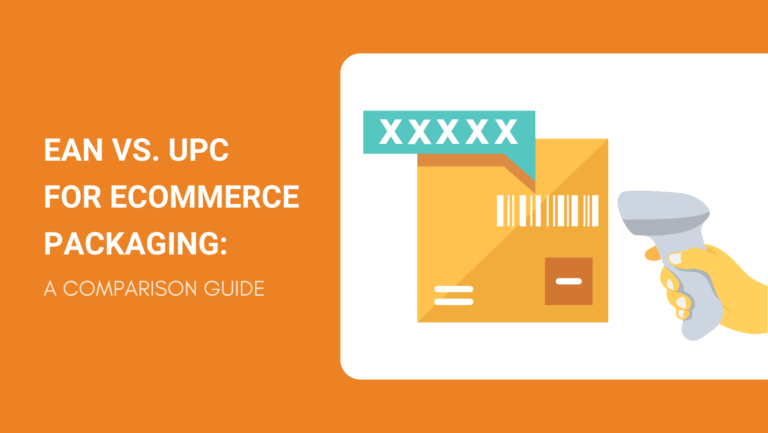Product packaging is a large part of eCommerce and comes with different types of barcodes for product identification, such as EAN and UPC.
However, there’s significant confusion about the real difference between EAN and UPC. They’re very similar – one is 13 digits and the other one 12 digits. So, how are they really different from each other? And, which one do you need to use?
Let’s dive into this EAN vs. UPC comparison guide with the latest 2023 information.
What Is a Barcode?
Simply put, a barcode is a visual pattern of bars and spaces (parallel and vertical lines varying in thickness) that serves for product identification by storing data about a specific product.
Barcodes are used for accurate and efficient warehouse and inventory storage management.
UPCs, EANs, and sometimes even SKUs use barcodes since they are machine-readable numbers, allowing companies to use a barcode scanner for easier tracking and listing.
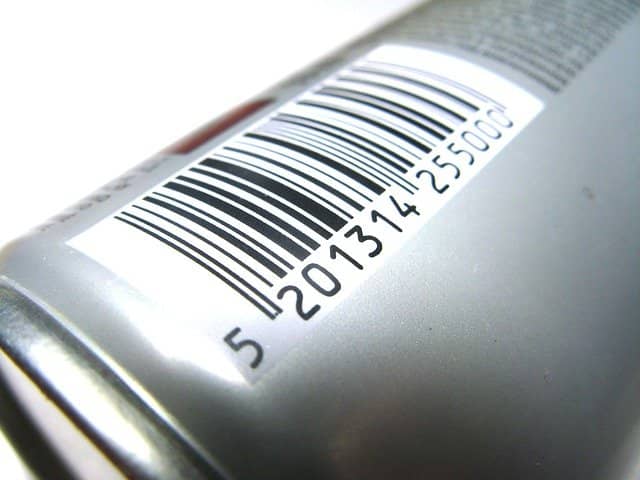
What Is a UPC Barcode?
Designed by George Laurer in 1973, the barcode concept UPC stands for Universal Product Code. Traditionally, the UPC code is suitable and used throughout US and Canada markets.
The UPC barcode number usually contains 12 digits or human-readable numbers. It’s missing the first one that an EAN code has which represents country codes. However, the country code for Canada and the USA is 0, so UPCs omit the zero and end up with just 12 digits.
If you have a business that deals exclusively within the US or Canada, it’s better to stick to UPC codes. That’s because many older inventory systems don’t have the options for the input of 13 digits or can’t register EAN codes yet.
What Is an EAN Barcode?
The EAN code was developed in 1976. It’s quite literally the European variant of the UPC barcode. EAN stands for European Article Number (recently known as International Article Number).
Unlike UPC barcodes, EAN barcodes display all 13 digits in human-readable form, the first one being the country code. The EAN barcode was designed applicable to many different countries. Being international in nature, it was necessary to add the country code as well.
Although you might encounter some older systems that don’t support EAN codes, note that since 2005, every barcode scanner in the US must be able to read both barcodes.
Composition of EAN and UPC
The EAN and UPC barcodes are usually comprised of four components:
- Country code – 1-3 digits (only for EAN codes)
- Manufacturer code (GS1 prefix) – all products from the same manufacturer will have this code – varying length (sometimes 5 digits)
- Product code – varying length (manufacturer code and product code usually equal 9 or 10 digits together)
- Check digit – one additional digit at the end of the sequence that serves to verify correct scanning
UPC barcodes have the same structure, only without the country code in front. That’s why UPCs are always 12 digits and EANs are 13 digits.

The Difference between EAN and UPC Codes
The EAN and UPC barcodes are identical in both the data and content of the bars and spaces and the use and the way digits are encoded.
However, EAN contains one extra number that signifies the country code (13 digits in total), while UPC omits this number and ends up with only 12 digits. Furthermore, the EAN barcode is used in the EU and all other countries except the USA and Canada which use the UPC barcode.
So, to a barcode scanner, there’s absolutely no difference between EANs and UPCs. The only differences are in the human-readable number of characters and the geographical region where both codes are used.
EAN vs. UPC: Table Comparison
Let’s look at EAN and UPC compared visually for a better understanding of the differences and similarities between the two:
| Barcode Type | EAN | UPC |
| Common Variations | EAN-13, EAN-8 | UPC-A, UPC-E |
| Number of Digits | 13 digits | 12 digits |
| Source | GS1 UK | GS1 US |
| Error Detection | a modulo-10 check digit | a modulo-10 check digit |
| Usage | retail PoS, inventory management | retail PoS, inventory management |
| Geographical Area | EU/international | USA and Canada |
GTIN vs. EAN, UPC, ISBN
GTIN stands for Global Trade Item Number and it represents the broad term for the human-readable number you see under barcodes. EAN, UPC, and ISBN codes are all different types of GTINs.
EAN and UPC are the barcode product identifiers or GTINs used in the EU and US, respectively. ISBN, on the other hand, stands for International Standard Book Number, and it’s a 10 to 13-digit GTIN assigned to identify books.
Shortly put, all EANs, UPCs, and ISBNs are GTINs. But, not all GTINs are EANs or UPCs.
How to Convert UPC to EAN?
To convert your UPC to EAN-13 symbols, you can just add the country code number in the front of the 12-digit sequence, which is always a zero for the USA.
Example of a UPC code: 123456789012
Example of the same EAN code: 0123456789012
How to Convert EAN to UPC?
It’s easy to convert UPC to EAN since we’re adding a zero in front of the US country code. However, it’s not possible to convert EAN to UPC simply because UPC is limited to 12 digits and doesn’t include country codes (it’s designed for US products with a country code of 0).
So, if your product is registered in markets outside North America, it gets an EAN code. The good news is that since 2005, all US retailers and PoS have been obliged to have barcode scanners that read and register 13 digits. So, in most cases, using EAN instead of UPC will be completely fine.
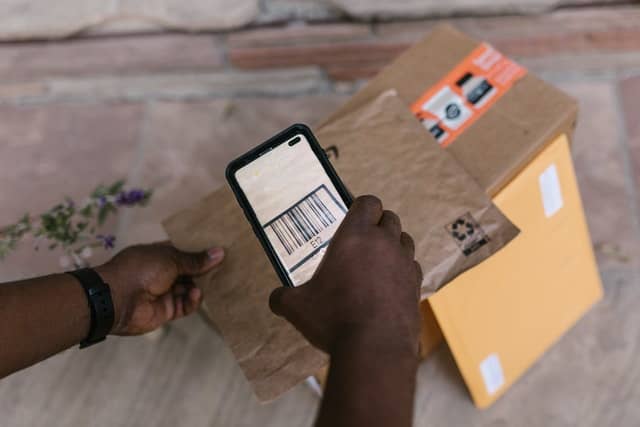
How to Get an EAN/UPC Code?
If you’re the manufacturer of a product, you can get UPCs from GS1 US. Alternatively, a slightly more affordable option is to get EANs instead from GS1 UK. In most cases, using a UPC or an EAN code makes no difference.
On the other hand, if you’re just reselling a registered product, ask your manufacturer for the UPC or EAN code (otherwise called simply a bar code or a product ID).
Here are the exact steps to follow:
Step 1: Calculate the Number of Codes
First, you need to calculate the number of UPC or EAN codes needed. Remember that you need a different barcode for each product variant (colors, sizes, etc.).
For instance, if you’re selling 3 types of T-shirt patterns in 3 different sizes, you’ll need 9 unique UPCs or EANs.
Knowing the number of unique barcodes needed is important for pricing and planning your expenses.
Step 2: Apply for a Company Prefix
Once you’ve figured out the number of codes you need to purchase, you can head over to GS1 US or GS1 UK to register for a company prefix.
Applying for a company prefix entails providing information such as:
- Your legal company name
- Contact information
- Number of individual items for product identification
- Your payment information
Step 3: Get the Prefix Certificate and Barcodes
You pay an initial fee and get your prefix certificate and membership access to your barcodes. The initial fee depends on the number of barcodes needed.
Step 4: Renew Your Barcodes Yearly
Your company prefix and barcodes will be valid and active for one year. Afterward, you need to renew your membership and pay again. This time, the charges are smaller than the initial fees.
Should You Get a UPC/EAN from GS1 or a Third-Party Vendor?
No matter the type of code you decide to use, we recommend sticking to GS1 codes rather than third-party vendors. Buying your codes from official GS1 sources will ensure that your company’s ownership of the product is protected within the code and that you’re buying a legit code that’s unique to your product.
Often, smaller eCommerce owners don’t need an entire bundle of UPCs but only a few, so they decide to purchase individual barcodes from third-party vendors. However, note that these UPCs are usually registered under another company prefix.
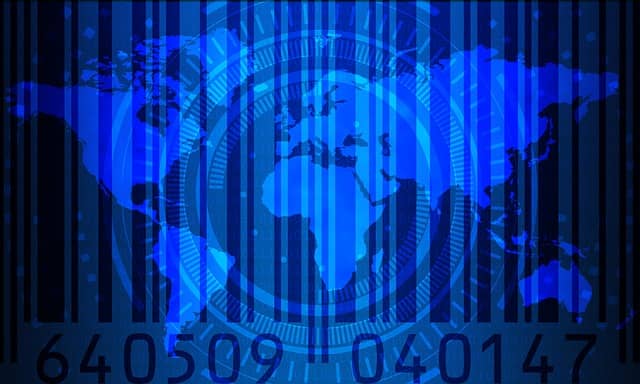
FAQs about EAN and UPC Codes
Now, let’s take a look at some of the most frequently asked questions on the subject of EAN vs. UPC barcodes:
What Is the UPC and EAN Code on Amazon?
Amazon requires their sellers to use an EAN or a UPC for most products they list. You can either ask your manufacturer for this barcode or if you produce the item, purchase barcodes from GS1 US, GS1 UK, or another official GS1 website.
You can use the same UPC or EAN code for products that you sell on Amazon on other marketplaces. The important thing is that each product variant has its own unique code.
Don’t mix the UPC or EAN barcodes with the ASIN number. The ASIN acronym stands for “Amazon Standard Identification Number” and Amazon assigns this number to every product sold on their marketplace, regardless if we’re talking about FBA or FBM.
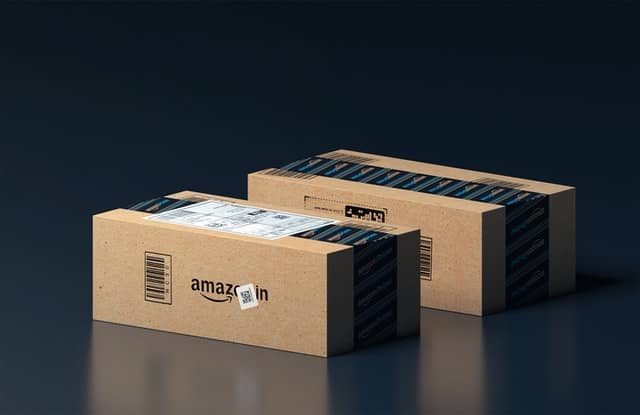
Do I Need a Barcode to Sell on My Own Website?
It depends. If you do self-fulfillment or work with a dropshipping agent, you don’t necessarily need a barcode. The same goes for many D2C brands that sell to end consumers directly.
However, if you use Amazon FBA or sell on marketplaces like eBay or Google Shopping, you will need a product identifier in the form of a barcode.
Do I Need to Get an EAN If I Already Have a UPC?
If you already have a UPC barcode, you don’t need to get an EAN. However, if at some point, you do start needing an EAN barcode or there’s a form requiring 13 digits, simply add a zero in front of the 12-digit code and you have your EAN!
Do You Need a Separate EAN/UPC for Each Product Version?
Yes. Each product variation (size, color, model, etc.) needs a unique UPC or EAN code. UPC numbers are not unique to a store. If two or three stores sell the exact same product, the products will have the same UPC or EAN barcode.
The UPC or EAN codes are tied to the product type. So, each unique product from that manufacturer will have its own UPC. This applies to different sizes, patterns, models, colors, etc.

Summary
Learning the difference between EAN and UPC will help you track and manage your product catalogs, marketplaces, and sales channels much more efficiently. And, as you can see, they’re practically the same thing, with the exception of the regions where they’re used.
So, for US retailers that already have a UPC, there’s nothing to worry about. Adding a 0 in the front is all you need to transform your UPC into an EAN.
All in all, we sincerely hope that this EAN vs. UPC comparison guide has helped you understand how product identifiers and barcodes work for retailers around the world.
Need a helping hand to source your products from China? Simply send us a sourcing brief and get a free quote.
